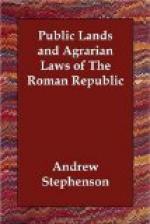From another point of view Roman colonies were similar to those of Greece, since their result was to remove from the centre to distant places the superabundant population, the dangerous,[7] unquiet, and turbulent.
But the difference in the location of the colonies was easy to distinguish. In general the Phoenicians and the Greeks as well as modern people founded their colonies in unoccupied localities. Here they raised up new towns which were located in places favorable to maritime and commercial relations. The Romans, on the contrary, avoided establishing colonies in new places. When they had taken possession of a city, they expelled from it a part of the inhabitants, whether to transfer them to Rome as at first, or a little later, when it became necessary to discourage the increase of Roman population, to more distant places. The population thus expelled was replaced with Roman and Latin citizens.[8] Thus a permanent garrison was located which assured the submission of the neighboring countries and arrested in its incipiency every attempt at revolt. In every respect these colonies remained under surveillance and in a dependence the most complete and absolute upon the mother city, Rome. Colonies never became the means of providing for the impoverished and degraded until the time of Gaius Gracchus. When new territory was conquered, there went the citizen soldier. Thus these colonies mark the growth of Roman dominion as the circumscribed rings mark the annual growth of a tree. These colonies were of two kinds, Latin and Roman.
1. Latin colonies were those[9] which were composed of Latini and Hernici, or Romans enjoying the same rights as these, i.e. possessed of the Latin right rather than the Roman franchise. They were established inland as road fortresses and being located in the vicinity of mountain passes or main thoroughfares acted as a guard to Rome, and held the enemy in check.
2. Roman, or Burgess, colonies[10] were those composed wholly of Roman citizens who kept their political rights and consequent close union with their native city. In some cases Latini were given the full franchise and permitted to join these colonies. In position as well as rights, these colonies were distinguished from the Latin, being with few exceptions situated upon the coast and thus acting as guards against foreign invasion.
Table of Latin Colonies in Italy.
------------------+----------------+-------+-----------
-------------------- COLONIES. | LOCATION. | B.C. | AUTHORITIES. ------------------+----------------+-------+----------------
--------------- 1 Signia. | Latium. | ? | Livy, 1, 56; Dionys., 4, 63. 2 Cerceii. | " | ? | Id. 3 Suessa Pometia.| " | ? | Livy, 2, 16. 4 Cora. | " | ? | Livy, 2, 16. 5 Velitrae. | " | 494 | Livy, 2, 30, 31 ; Dionys., | | | 6, 42, 43.




